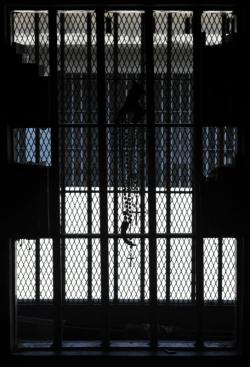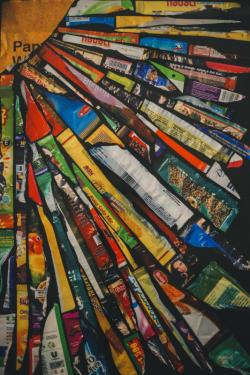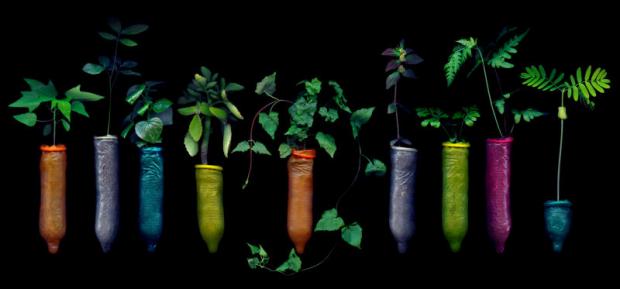Torn scraps of gaudy snack packages, pairs of slippers, multicoloured condoms glowing like improbable rainbows through back lighting. These are the images of everyday objects wrought with meaning, reminders of life in a place where small things mean a lot.
Yogyakarta-born photographer Angki Purbandono is in Bangkok this week. He has no qualms about telling people he has served time for a drug offence.
But like all things in life, he said the experience served its purpose. For one, it led to his current exhibition, a collection of contemporary photographs titled "Grey Area", showing at Bangkok University Gallery.
The 46-year-old has chronicled memories of his incarceration through scanography, a process used to create digital images using a flatbed scanner in a manner it was not originally intended for. The resulting pictures present a slightly altered reality and texture that heightens the perception of the viewers.
"Being in the slammer was a blessing in disguise for me," said Purbandono.
"I learned so much about prison life, my inmates and prison staff. With the help and support of a sympathising warden and cellmates, in particular Ridwan Fatkhunodin, who helped to collaborate with me on this project, I was able to patch together my memories during my time inside.
"What made me excited about the entire experience is the fact that I was able to introduce scanography to my fellow inmates. A number of them were keen to learn and pursue it as a career once they completed their sentences."

A poignant image of life behind bars. Wanlaporn Chanchao.
Purbandono, one of Yogyakarta's celebrated photographers, has set up a prison art foundation to assist not just former inmates continue with their passion for art but also encourage anyone who is associated to them to also join.
Contemporary photography today in Yogyakarta is thriving, he said. To his delight, young artists are experimenting with not just multimedia tools, but also applying their senses to conceptualise ideas, the outcome of which has been spellbinding, he mused.
The quirky artist, who has a dry sense of humour, was sentenced to a year for taking and possessing marijuana in 2012-2013. He was out in 10 months for good behaviour. He admits that if it wasn't for prison warden Yoga's support in this project, he wouldn't have been able to create the series of photographs that capture the surreal moments of prison life within the confines of space, place and equipment.
"I consider myself very fortunate. There is a very slim chance of doing the type of project I did while in prison," admitted the Indonesian photographer. "Till this day I don't know what made warden Yoga decide to give me the green light.
"The idea of using scanography came about because cameras are not allowed in prison. As a photographer, I knew that another way to create an image would be to use a scanner. I requested if I could take a scanner and a my Mac computer with me, and prison authorities agreed.
"Maybe the warden knew who I was, and so decided that not only should I be allowed to take this equipment with me, but also be allowed to work on this project from 7.30am to noon every day. It was a surreal experience.
"Certain portions of the artwork were co-produced with the warden and other inmates. Yes, a handful of them helped conceptualise and contributed in gathering objects you see in each photo.
"For the duration of time I was locked up, I managed to turn a stifling, controlled environment into an opportunity to do the unexpected. Probably that is one of the reasons this collection has a mix and match of things that seem also unanticipated."
The outcome of this is the Grey Area collection, a tapestry of thought-provoking artwork, based on the close bonds people form in adversity.

One among a handful of exhibits at Angki Purbandono's contemporary photography exhibition. Wanlaporn Chanchao.
While walking us through a couple of his exhibits, the unorthodox artist said that despite using scanography art for sometime now, the prison art collection has been one of the most rewarding in terms of personal accomplishment.
We stopped at the piece titled Material Ethic, a collection of colourful wrappers, diagonally placed and scanned to offer depth and visual power. His curiosity and belief in thinking out of the box very much set the wheels in motion for the photo.
Describing his take on it, he said: "Wrappers are useless objects for most people. However, to me they were important. Those small useless objects made me think of two big philosophies: beauty and flexibility in life. It was a poignant reminder for me about life while I was behind bars. My cellmates helped brainstorm to get the idea off the ground."
Next stop was Out Of The Box, prison bars framing an inmate's view of what is transpiring outside his cell. Purbandono said as a camera was not allowed in the prison, he felt like an opportunity arose when warden Yoga showed a keen desire to learn photography, the technique and creative side of it.
So the photo was snapped by none other than the warden himself. It was at the time of silhouette photography lessons that the warden was taught how decorations on the window of the cell can enable the photographer to capture the inside out perspective.
With a heading such as Sandal United, one gets curious about the story behind it. Regaling us with the account, he explained that after his third pair of sandals were stolen, he decided to go bare foot. To curb what was slowly becoming a practice, inmates began putting personal signs on their sandals to symbolise ownership.
What he came away with was this: "This situation taught me two things -- one that inmates, like anyone else, have a sense of pride when it comes to their personal items and two, they unite when it comes to collectively finding a plausible explanation to a pressing situation."
Condom And Earth grabs your attention as soon as you set your eyes on the colourful condoms with mud and plants growing in them. The concept is simple.
"Despite the distance between them and their loved one, inmates stand firm in the belief that they will survive the wait to feel their warmth again," he said.
When it came to the piece Legalised Illegal, Purbandono decided to take a slightly different approach in his presentation.
"Here we have a photo calendar of all the different types of activities my wife Diane did while I was in prison," he said. "It is a photo diary for Angki. She compiled this for me because she knew I was worried about her. For her, the click of the shutter was effortless, but for me, the photos meant a lot. I felt a sense of connection despite being away from her."
One comes out of Purbandono's solo exhibition enlightened, largely because he has managed to use the power of contemporary photography to bring to his audience a story of resilience and courage in the most adverse of conditions.
Purbandono's exhibition will be held until July 26 at Bangkok University Gallery, City campus.

While Angki Purbandono's exhibits come from whatever he could get his hands on in prison, they are a constant reminder of life in its many dimensions. Wanlaporn Chanchao.

